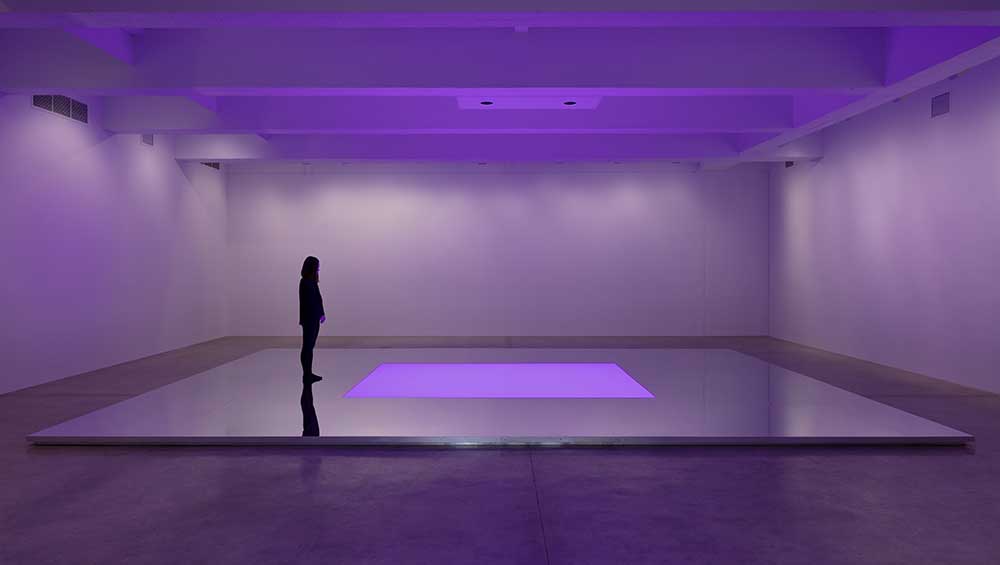
Kimsooja: Meta-Painting, installation view, Tanya Bonakdar Gallery, New York, 12 April – 14 June 2024. Photo: Pierre Le Hors. Courtesy the artist and Tanya Bonakdar Gallery, New York / Los Angeles.
Tanya Bonakdar, New York
12 April – 14 June 2024
by LILLY WEI
Kimsooja’s exhibition at Tanya Bonakdar is her first solo show in New York in nearly two decades and a welcome chance to see what she has been up to of late. The artist (b1957, Daegu, South Korea) has impeccable international art world credentials and is an influential presence in top-tier exhibitions and venues across the globe: documenta 14 (2017); the 55th Venice Biennale (2013), representing Korea; the 24th São Paulo Biennial (1998), ditto; participating in more than 30 biennials and triennials in the last three decades – and the list goes on.
Much admired as a conceptual and performance artist, Kimsooja is a film-maker, photographer and sculptor, her increasingly immersive installations a combination of these disciplines and site-responsive, often incorporating textiles, mirrors, light and sound. Another characteristic of her oeuvre is the distinctive, unforced synthesis of the artistic traditions and philosophies of her native Korea with contemporary western visual practices and techniques. A cosmopolite studying art in Seoul and Paris and a longtime resident of those cities and New York, as a site-specific installation artist, she travels the world for the sake of her art.
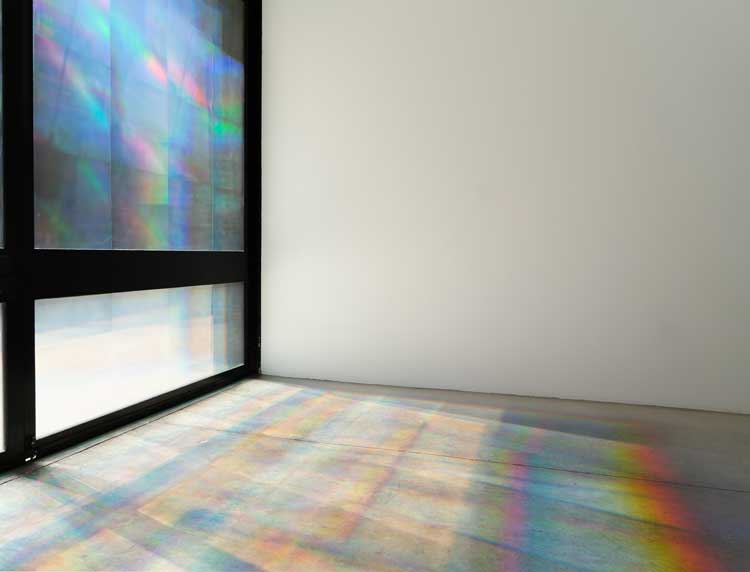
Kimsooja, To Breathe, 2024. Diffraction grating film on windows, dimensions variable. Courtesy the artist and Tanya Bonakdar Gallery, New York / Los Angeles.
The works on display in Chelsea, New York, are from the past six years to the present. While they bear titles of projects originating much earlier, they are different iterations of them as her thinking constantly evolves, re-envisioning them, recontextualising them. To Breathe (2024) consists of diffraction grating film, a material that has become a favourite of hers, applied to the windows of the gallery, which causes the incident light to fracture into countless colliding rainbows under the right conditions, the effect like that of a magnificent aurora borealis. To Breathe (2015), located in the main space, consists of an enormous rectangular platform raised slightly above the floor, its pristine surface a mirror. At its centre is a projection that slowly shifts colours, suffusing the room in a series of glowing ethereal hues, as if painting in space, on air, its rhythmic cycle suggesting the steady inhalation and exhalation of breath, making us more aware of our own breathing, our own bodies.
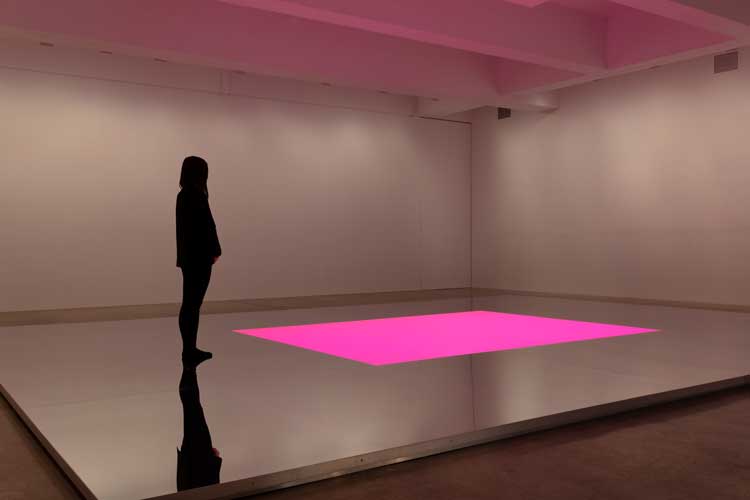
Kimsooja, To Breathe, 2015. Chromatic spectrum projection with mirror platform floor, Gallery installation, 9 x 675 x 900 cm, duration: 10 min, 32 sec. Installation view, Tanya Bonakdar Gallery, New York, 12 April – 14 June 2024. Photo: Pierre Le Hors. Courtesy the artist and Tanya Bonakdar Gallery, New York / Los Angeles.
The reflective surface of the platform doubles the room, opening it up, and also completing it, a kind of yin/yang balancing. Viewers, feet bootied, are invited to walk on the platform, but it can also be unsettling, as the ground seemingly disappears from underfoot, the room turned upside down, the force of gravity no longer as certain, and we become free-floating. Kimsooja once said that instead of building new spaces, she transforms existing ones. The physical space remains more or less as is, but it has been so visually and psychologically altered that it is experienced in an entirely different way.
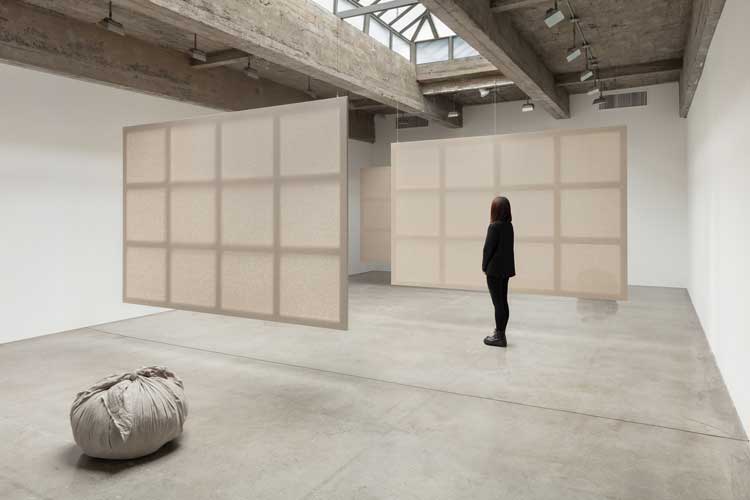
Installation view, Kimsooja: Meta-Painting, Tanya Bonakdar Gallery, New York, 12 April – 14 June 2024. Photo: Pierre Le Hors. Courtesy the artist and Tanya Bonakdar Gallery, New York / Los Angeles.
Upstairs, there is an installation of three unpainted linen canvases stretched over wooden frames, their grids visible through the finely woven, subtly sheened fabric, as if you were looking at the back of a painting or a screen, suspended from the ceiling to hover about two feet above the floor. Called Meta-Paintings (2024), they suggest potential, a state of fluidity and futurity in which the paintings are suspended temporarily, about to come into being, about to be constructed, a space for interweaving memories and feelings into structures that are intentionally indeterminate, a pause in between making and non-making, in complicity with the viewer.
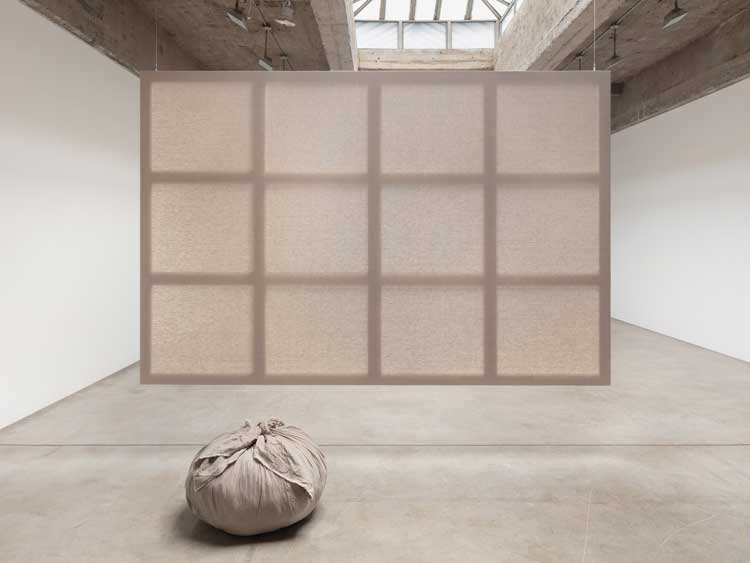
Kimsooja, Meta-Painting, 2024. Linen canvas stretched on wooden frame, bottari made of linen canvas and used linen clothes, 200 x 300 x 3 cm (painting), 48.3 x 73.7 x 71.1 cm (bottari). Courtesy the artist and Tanya Bonakdar Gallery, New York / Los Angeles.
They are accompanied by her signature bottari (wrapped cloth bundles that were the traditional Korean method of transporting possessions), made of the same fabric as the canvases, set on the floor, although in the past they have often been festively coloured and patterned, the materials more opulent. It is conceptually a critical form for her, drawing the commonplace and quotidian into the realm of art as a feminist stance, a form that she has returned to time and again since 1992. The bottari’s contents, although concealed, are chosen and packed with meticulous care – everything Kimsooja does is meticulous, with the classic elegance of the measured, the proportionate – often filled with clothing and objects from the locations of the show, and, like the unpainted paintings, also repositories for the invisible, the intangible. Carried by wanderers on their journeys, and emblematic of displacement, exile and impermanence, they symbolise the loss of home as well as a future in which a new home might be established. They also tell of the leavings and returns, voluntary and involuntary, that have become so inevitably, intractably part of contemporary life.
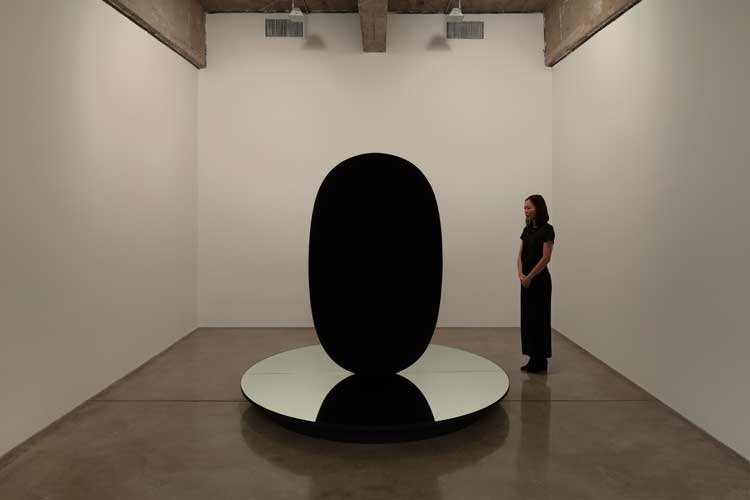
Kimsooja, Deductive Object, 2016. Cast aluminium, paint, mirror, wood, 183 x 110 x 110 cm (sculpture), 20.3 x 221 x 221 cm (base), 203.2 x 221 x 221 cm (overall). Photo: Pierre Le Hors. Courtesy the artist and Tanya Bonakdar Gallery, New York / Los Angeles
In the smaller upstairs project room, an upright six-foot-tall oval, Deductive Object (2016), far more imposing than its measurements and a bit of a visual conundrum, summons up Anish Kapoor’s optical feints. A dense, velvety, absorbent black, it is set on a mirrored base, the shape inspired by the Brahmanda stone, or “cosmic egg”, of Indian mythology, located at the centre of creation. It emerges twinned from the reflective circular surface, another manifestation of states of being and non-being, of coming into being. I walked around it several times, but it never seemed to change in shape. I thought it was flat, but I wasn’t sure; it didn’t seem to have an edge. But it didn’t seem to be three-dimensional either, the ambiguity intriguing, making it even more potent, mysterious, talismanic. I know my question could be resolved, but perhaps some things don’t need to be.
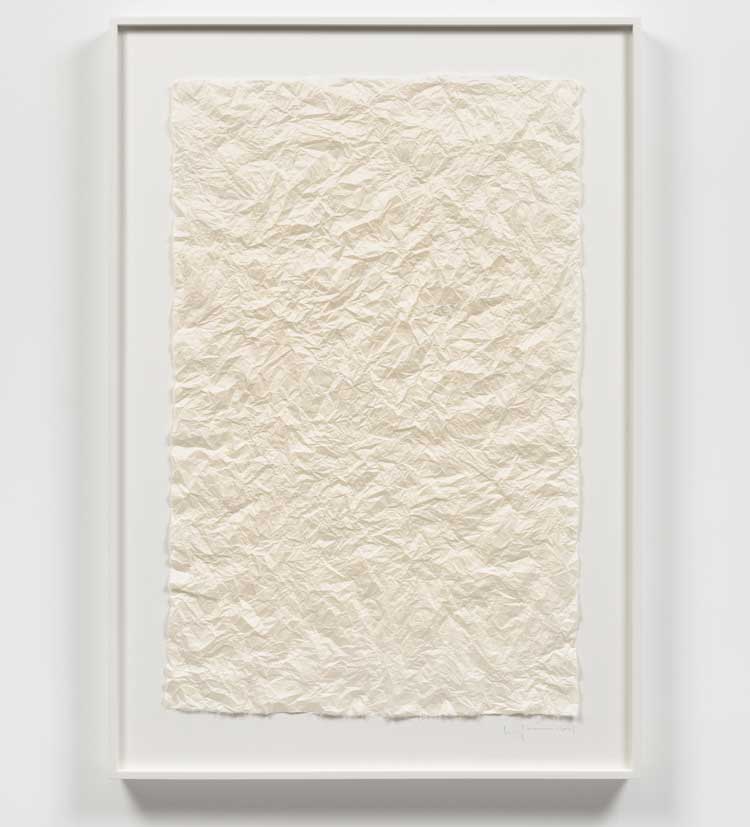
Kimsooja, Deductive Object: (Un)fold, 2023. Korean rice paper, 104.5 x 73 x 6 cm. Courtesy the artist and Tanya Bonakdar Gallery, New York / Los Angeles.
There are also three crumbled sheets of hanji paper, framed, called Deductive Object: (Un)fold (2023), nearby. To make them, the paper is crumpled in the artist’s hand, then released, smoothed back to its original shape, but with a surface that has now been marked, irrevocably changed, describing the act of creation in its purest, most primary gesture, one that lies at the core of Kimsooja’s art.
• The installation, Kimsooja: To Breathe – Constellation, is at the Bourse de Commerce – Pinault Collection, Paris, as part of the exhibition Le monde comme il va until 2 September 2024.